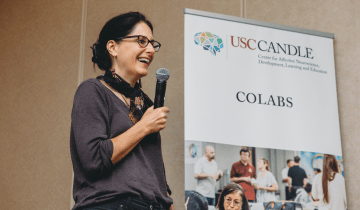The need for effective professional development (PD) opportunities for teachers is a topic that comes up frequently in K–12 education, especially when addressing the teacher shortage and teacher burnout. Despite millions of dollars and hours being spent on PD for teachers, claims about effectiveness can be murky. Since 2017, Associate Professor Yasemin Copur-Gencturk has been researching the impact of interactive, computer-based teacher PD for middle school math teachers on student performance through the creation of an AI-driven PD program. Her research, resulting from a program designed with a virtual facilitator based on natural language processing (AI tool), shows that artificial intelligence (AI) is a promising tool for creating effective, scalable teacher PD.
A passion for improving math instruction
With experience as a high school math teacher early in her career in her native Turkey, Copur-Gencturk understands the challenges that math teachers encounter and has centered her scholarship on both math conceptual knowledge and pedagogical content knowledge to help teachers improve their classroom performance. Improving math instruction has been a professional passion for Copur-Gencturk. She has felt that the way math has been taught is mainly procedural, leaving little room for students to see how concepts are connected across grade levels. How teachers make sense of concepts relates to how they teach. When teachers can see how the concepts build on one another, they are more likely to have success in teaching their students.
“This research comes out of my desire to find ways to improve the instruction of mathematics,” said Copur-Gencturk. “Computer-based programs have been widely used with school-age kids, but they haven’t been used as much with teachers. So this was part of the motivation for me to find a way to scale up effective programs so that teachers can complete their training anytime and anywhere.”
The program that Copur-Gencturk and her colleagues initially designed was intended to be scalable and accessible to any teacher. The sample recruitment was nationwide for sixth and seventh-grade math teachers, including those from cities, suburbs and rural regions. A challenge with teacher PD is that the research shows that many initiatives aren’t effective in changing teacher practices and at improving student learning outcomes. Yet, Copur-Gencturk and her team found that the students of teachers who completed the online PD program powered by AI had higher test scores after their teachers completed the program. The impact of the computerized intervention was positive, providing proof of concept that AI-based tools can be used effectively to analyze teacher performance and provide individualized feedback. In addition, the research could lead a step away from less effective PD programs which are typically not tailored toward individual needs. The pilot program also provided confidentiality for teachers’ responses and the AI virtual facilitator’s feedback, which could prompt teachers who may normally be hesitant to share their ideas in person to express themselves more freely online.

Building upon this research for middle school math teachers, Copur-Gencturk recently received a $2 million National Science Foundation (NSF) grant to create a program for preservice math teachers to improve content knowledge and pedagogical content knowledge through an interactive program with personalized feedback. She will be the principal investigator and work with co-principal investigators Jiliang Tang from Michigan State University and Al Cohen and Shiyu Wang from the University of Georgia.
PD anywhere and any time
Preservice teachers can have varying degrees of access to learning opportunities, depending on their location or the teaching credential program in which they enroll. Teacher education programs have faced cuts in the past several years, and these cuts are a consequence of the declining investment in public education. Rural teachers are particularly challenged because they often do not have adequate access to PD. This research project with the new NSF grant will continue to be national in scope.
“While there has been online instruction in teacher education for some time, people have quit these programs because of the lack of interaction. We need to find a way to reach teachers anywhere and anytime to provide quality feedback, and this is where AI comes in,” said Copur-Gencturk.
Online PD programs with AI can save time for teachers and be more cost-effective. While in-person PD is beneficial, online professional development with AI can save time and still provide teachers feedback based on their needs. For the initial program, Copur-Gencturk and her team used a virtual agent supported by natural language processing to analyze the middle school math teachers’ interactions with learning activities and provide personalized, timely feedback in their asynchronous online PD program. Teachers receive immediate and actionable feedback, so that they aren’t receiving it long after they have made a mistake or have mentally moved beyond the context of where the mistake occurred. Additionally, there’s a cost saving without having to utilize in-person instructors for these exercises.
This newly funded project will research the extent to which AI can reliably detect preservice teachers’ responses. The effectiveness of the program on preservice teachers’ knowledge of middle school math and teaching skills will be examined through a randomized controlled trial with a sample of 200 preservice teachers. The program will be refined through an interactive design cycle, based on feedback from instructors of mathematics methods courses and from preservice teachers. Additionally, the research will have a sample that is national in scope to be able to be more generalizable and fit the needs of teachers regardless of their location or the type of students they encounter.
Using AI in teacher PD isn’t about replacing personnel. For Copur-Gencturk, using AI is about reshaping how educators think about teacher PD and teacher training. Sometimes there isn’t enough time or resources in teacher education programs to cover all of the concepts that new teachers should know.
“While the topic of AI in the workplace is hot and widely discussed, this program is something we have been working on for several years. Ultimately, this is about reshaping how we think about and conduct teacher education and professional development,” said Copur-Gencturk. “We want to find ways to incorporate some of the technological advances to be more efficient and to reach more teachers. This program is supplementary, it's not really meant to replace people.”
Eventually, Copur-Gencturk would like to expand content area training in math to include all of pre-K through grade 12. For now, the program is only for upper elementary and middle school teachers.





